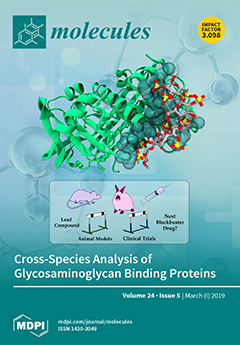Twenty-five new derivatives of 8-hydroxycycloberberine (
1) were synthesized and evaluated for their activities against Gram-positive bacteria, taking
1 as the lead. Part of them displayed satisfactory antibacterial activities against methicillin-susceptible
Staphylococcus aureus (MSSA) and methicillin-resistant
Staphylococcus aureus (MRSA), as well as
[...] Read more.
Twenty-five new derivatives of 8-hydroxycycloberberine (
1) were synthesized and evaluated for their activities against Gram-positive bacteria, taking
1 as the lead. Part of them displayed satisfactory antibacterial activities against methicillin-susceptible
Staphylococcus aureus (MSSA) and methicillin-resistant
Staphylococcus aureus (MRSA), as well as vancomycin-intermediate
Staphylococcus aureus (VISA). Especially, compound
15a displayed an excellent anti-MRSA activity with MICs (minimum inhibitory concentrations) of 0.25–0.5 μg/mL, better than that of
1. It also displayed high stability in liver microsomes and whole blood, and the LD
50 value of over 65.6 mg·kg
−1 in mice via intravenous route, suggesting a good druglike feature. The mode of action showed that
15a could effectively suppress topo IV-mediated decatenation activity at the concentration of 7.5 μg/mL, through binding a different active pocket of bacterial topo IV from quinolones. Taken together, the derivatives of
1 constituted a promising kind of anti-MRSA agents with a unique chemical scaffold and a specific biological mechanism, and compound
15a has been chosen for the next investigation.
Full article






